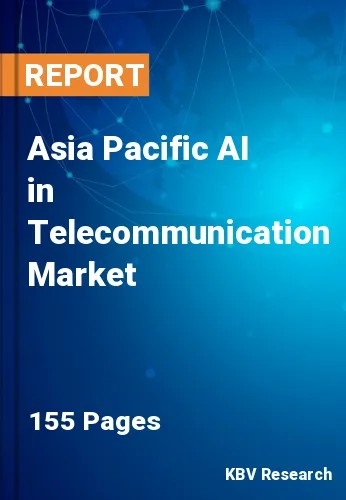The Asia Pacific AI in Telecommunication Market would witness market growth of 41.0% CAGR during the forecast period (2023-2030).
Network slicing, a key feature of 5G technology, is being augmented by AI to optimize resource allocation and enhance network efficiency. AI-driven network slicing allows telecommunication providers to dynamically allocate network resources based on the unique requirements of diverse applications, from massive IoT deployments to ultra-reliable low-latency communications. In addition, as AI applications become more integral to telecommunication decision-making, the need for transparency and explain ability in AI algorithms is gaining prominence. Explainable AI (XAI) ensures that the decision-making processes of AI systems are understandable and interpretable, addressing concerns related to bias, accountability, and regulatory compliance.
Additionally, the escalating threat landscape in cyberspace has prompted the integration of AI into telecommunication network security. AI-driven threat detection systems analyze network traffic patterns, identify anomalies, and proactively respond to potential security breaches. This trend reflects the industry's commitment to fortifying networks against evolving cybersecurity threats. Moreover, the groundwork for 6G technology is being laid with a strong emphasis on AI-driven network automation. Telecommunication providers are leveraging AI to create self-optimizing networks capable of adapting to dynamic conditions and anticipating future network requirements. This trend sets the stage for the evolution towards 6G, where AI will play a more central role.
The Indian government's initiatives, such as the Digital India campaign, aim to accelerate the adoption of digital technologies across the country. This includes a focus on expanding broadband connectivity, enhancing digital infrastructure, and promoting the use of AI in various sectors, including telecommunications. Government support creates a conducive environment for AI integration in the industry. As per the data released in 2023 from Invest India, the telecom industry is one of the most important sectors in the Indian economy, with a 6.5% contribution to the country's GDP. In the last quarter of FY 2022-2023, the industry’s gross revenue was INR 85,356 Cr ($11.38 Bn). Hence, expanding telecom sector in Asia Pacific will assist in the growth of the regional market.
The China market dominated the Asia Pacific AI in Telecommunication Market by Country in 2022, and would continue to be a dominant market till 2030; thereby, achieving a market value of $1,888.9 million by 2030. The Japan market is registering a CAGR of 40.1% during (2023 - 2030). Additionally, The India market would showcase a CAGR of 41.9% during (2023 - 2030).
Free Valuable Insights: The Global AI in Telecommunication Market is Predict to reach $ 21.2 Billion by 2030, at a CAGR of 40.4%
Based on Component, the market is segmented into Solution and Service. Based on Deployment, the market is segmented into On-premises and Cloud. Based on Technology, the market is segmented into Machine Learning, Natural Language Processing (NLP), Data Analytics and Others. Based on Application, the market is segmented into Network Optimization, Virtual Assistance, Customer Analytics, Self-Diagnostics, Network Security and Others. Based on countries, the market is segmented into China, Japan, India, South Korea, Singapore, Malaysia, and Rest of Asia Pacific.
By Component
By Deployment
By Technology
By Application
By Country
Our team of dedicated experts can provide you with attractive expansion opportunities for your business.

